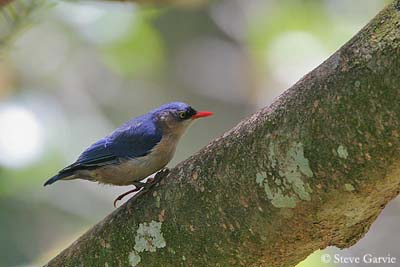
Velvet-fronted Nuthatch
Sitta frontalis
Passeriforme Order – Sittidae Family
BIOMETRICS:
Length: 12-13 cm
Weight: 9-17 g
DESCRIPTION:
Velvet-fronted Nuthatch is one of the prettiest birds of the Sittidae Family, with its nice colours and details.
Adult male has violet-blue upperparts, crown, lesser and median upperwing coverts and uppertail. Alula, primary coverts and outer primaries are blackish. Other feathers are fringed violet-blue, grey-blue or greyish-black.
On the underparts, chin and throat are whitish whereas breast is dull beige. Flanks, belly and vent are duller and slightly darker. Undertail coverts are whitish, slightly washed lavender. Underwing is black and whitish.
On the head, crown is violet-blue and forehead is black. Male shows black lores and narrow postocular line. Ear-coverts are washed lavender.
The straight bill is bright red. Eyes are yellow, as the eye-ring. Legs and feet are blackish.
Female is almost similar, but she lacks the black postocular stripe and shows deeper colours on underparts.
Juvenile is duller than adults and has blackish eyes.
Fr : Sittelle veloutée
All : Samtstirnkleiber
Esp: Trepador Piquirrojo
Ital: Picchio muratore frontevellutata
Nd: Fluweelvoorhoofd-boomklever
Russe: Чернолобый поползень
Photographs by Steve Garvie
RAINBIRDER Photo galleries
Text by Nicole Bouglouan
Sources:
HANDBOOK OF THE BIRDS OF THE WORLD Vol 13 by Josep del Hoyo-Andrew Elliot-Jordi Sargatal - Lynx Edicions – ISBN: 9788496553453
Wikipedia (Wikipedia, The Free Encyclopedia)

We find five subspecies sharing the range. They slightly differ in colour intensity on the underparts.
VOICE: SOUNDS BY XENO-CANTO
Velvet-fronted Nuthatch is a noisy species. Its common call “sit-sit-sit” or “chip-chip-chip” allows locating the bird. Some variants and longer phrases are also uttered in flight ‘chip-chip-sit-sit-sit-sit”.
Song is a series of “sit” notes which may become a fast, hard rattle.
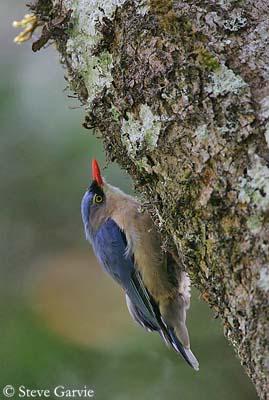
HABITAT:
Velvet-fronted Nuthatch frequents several types of forests such as tropical and wet forests, evergreen, deciduous, pine and mixed forests, bamboo jungles, various plantations and mature mangroves.
It usually prefers more open types than closed-canopy forests.
This species may be seen mainly at low elevation, but also from plains up to 1500-1800-2200 metres according to the range.
RANGE:
Velvet-fronted Nuthatch is resident in its range. It is found in S Asia, from Pakistan, India and Sri Lanka, to S China and Indonesia.
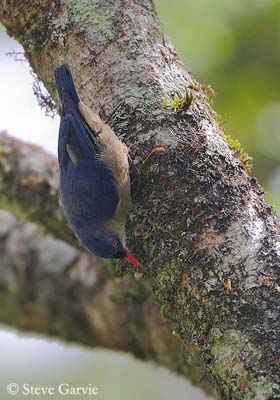
BEHAVIOUR:
Velvet-fronted Nuthatch is always very active, foraging on tree trunks in pairs or in small groups of 4 to 6 birds.
It usually forages in upper and middle storey of tall trees, but it also may be seen searching for insects and spiders in undergrowth or on fallen logs.
Like other nuthatches, Velvet-fronted Nuthatch is able to climb down trees head first, to hang upside-down and to explore the underside of the branches.
It also waits for insects in front of the trunks while performing active wing-flapping.
Like other nuthatches, it defends vigorously the territory during the breeding season, but as a resident species, Velvet-fronted Nuthatch defends it all year round. Usually, the territory provides abundant food resources.
Velvet-fronted Nuthatch is often seen in small groups or joins mixed-species flocks if this group enters the territory, and leaves it as the flock moves out.
Velvet-fronted Nuthatch is a cavity-nester, using tree holes or crevices at various heights above the ground, but often at about 7 metres in tree. The hole often needs some works such as to enlarge the entrance and the cavity, or to reduce them by adding a kind of mud wall.
FLIGHT:
Velvet-fronted Nuthatch performs fairly strong flight. The flight is direct over short distance, and mostly undulating on longer distances.
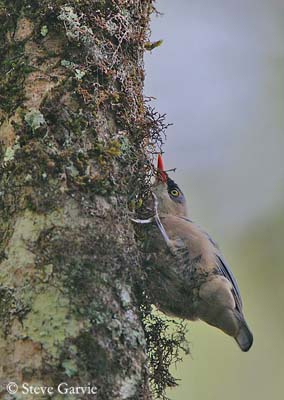
REPRODUCTION:
Breeding season varies according to the range.
Velvet-fronted Nuthatch is a cavity-nester. The nest is a natural cavity such as hole in tree or crevice. It is built by both adults. The selected cavity is usually small and the birds enlarge it. The cup is made with moss and feathers, and lined with fur and feathers.
Female usually lays 3 to 6 white eggs with reddish or purple markings. The clutch may vary according to the range. Chicks are fed by both parents.
Incubation, nesting and fledging periods are unknown.
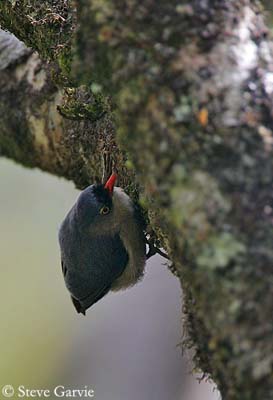
DIET:
Velvet-fronted Nuthatch feeds mainly on insects and spiders, often caught on tree-trunks and branches where the bird forages often upside-down.
PROTECTION / THREATS / STATUS:
Violet-fronted Nuthatch is threatened by habitat loss and deforestation.
However, this species is usually common in suitable habitat, but may be scarce or less abundant in some parts of the range.